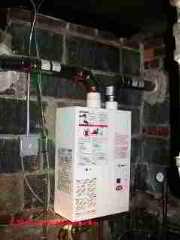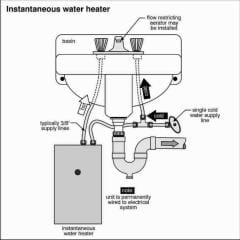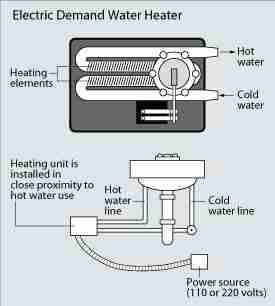 Tankless Water Heater Installation Requirements & Costs
Tankless Water Heater Installation Requirements & Costs
Demand Water Heaters or Instantaneous Water Heaters or
Endless Hot Water Systems
- POST a QUESTION or COMMENT about tankless water heaters, demand water heaters, & point of use water heaters: installation requirements & costs
Tankless Water Heater Installation Requirements & Costs:
This article explains the special installation requirements, purchase & installation costs, & operating costs of of tankless water heaters, also called instant water heaters or "on demand" water heaters.
Page top sketch of a point of use tankless water heater courtesy of Carson Dunlop Associates, a Toronto home inspection, education & report writing tool company [ carsondunlop.com ].
InspectAPedia tolerates no conflicts of interest. We have no relationship with advertisers, products, or services discussed at this website.
- Daniel Friedman, Publisher/Editor/Author - See WHO ARE WE?
Installation Requirements & Operating Cost of Tankless Water Heaters
 As we discussed at Problems & Defects, conventional water heaters are relatively inexpensive due to their simplicity while tankless water heaters are more expensive to purchase and install.
As we discussed at Problems & Defects, conventional water heaters are relatively inexpensive due to their simplicity while tankless water heaters are more expensive to purchase and install.
In 2009 in Toronto, Ontario a high capacity instantaneous water heater installation could cost $4000. CDN. Their complexity also means that maintenance and repairs can be more expensive.
Dedicated isolating valves help simplify draining and other regular maintenance.
Below we discuss some of the special requirements for installation of tankless water heaters, followed by a discussion of the operating cost of tankless water heating systems.
Article Contents
- TANKLESS WATER HEATER INSTALLATION REQUIREMENTS, COSTS
- Payback Analysis for Tankless Water Heater Installation & Use
- LP to Natural Gas Conversion for Tankless, Demand, Instantaneous, or Point of Use Water Heaters?
- INSTALLATION & OPERATING COSTS For Tankless Water Heaters
- UNEXPECTED COSTS - Instantaneous Water Heater Installation Costs
Sketch of a point of use tankless water heater shown above/left was provided courtesy of Carson Dunlop Associates, a Toronto home inspection, education & report writing tool company [ carsondunlop.com ].
According to the U.S. Department of Energy,
For homes that use 41 gallons or less of hot water daily, demand water heaters can be 24%–34% more energy efficient than conventional storage tank water heaters.
[Tankless water heaters] can be 8%–14% more energy efficient for homes that use a lot of hot water -- around 86 gallons per day.
You can achieve even greater energy savings of 27%–50% if you install a demand water heater at each hot water outlet [bathroom, laundry, etc] ENERGY STAR® estimates that a typical family can save $100 or more per year with an ENERGY STAR qualified tankless water heater.[15]
Note that this advice from DOE addresses hot water heating operating cost and does not include nor provide a payback period analysis that considers the purchase and installation cost for tankless or demand water heaters, though the DOE does observe that assuming a 20-year life for the tankless water heater,
The initial cost of a tankless water heater is greater than that of a conventional storage water heater, but tankless water heaters will typically last longer and have lower operating and energy costs, which could offset its higher purchase price. [15]
Note that this analysis does not include maintenance and repair costs that tend to be higher for tankless or demand water heaters, nor does it address hidden costs such as extra maintenance cost to address scale formation in areas of hard water, or the possible additional cost of a water softener or water conditioner that may be needed to protect the equipment.
When we compared two alternative solar water heater designs in 2011 we found that one company, Bosch, can provide a water heater designed to resist clogging and damage from scale formation in areas of water with high mineral content. We also observed that the cost of this installation was two to three times as much as other water heater models.
Payback Analysis for Tankless Water Heater Installation & Use
 In our OPINION, and accepting DOE's data at face value and ignoring the additional costs we have cited, the lifetime savings for a typical family installing a tankless water heater would be about
In our OPINION, and accepting DOE's data at face value and ignoring the additional costs we have cited, the lifetime savings for a typical family installing a tankless water heater would be about
20 years x $100./year savings = $2000 total savings in energy cost by using a tankless water heater over 20 years.
Image at left (U.S. DOE [15]) illustrates an electric demand type water heater that is the least costly to purchase and install per individual heater, though if multiple such heaters are needed in a home, the total cost can easily exceed the installed cost of a single tank type electric water heater.
Significant additional installation costs are likely for even this little electric unit if the electrician has to run a new 240V line to each point of installation.
Watch out: if money or return on investment is the principal reason you are considering converting to a demand type water heater, you should perform an accurate total cost analysis that reflects all of the costs to install, operate, & maintain both types of water heaters: a tank type water heater and a tankless or demand water heater - for purpose of comparison.
At POSSIBLE COSTS (including hidden costs) Involved in Converting to a Tankless or Demand Water Heater we list all of the costs likely to be involved in different approaches to producing hot water for washing & bathing in a building.
For example, and using the DOE data above, if we assume
- there was zero additional cost for maintenance and repairs of the tankless water heater over 20 years (probably over-optimistic),
- that a new tank-type water heater using the same fuel (gas or electric for example) could have been installed as an alternative, at a typical installed cost to replace an existing failed tank-type water heater runs around $1000.
- that the new tank type water heater would also have zero additional cost for maintenance and repairs over 20 years
- that the tankless water heater conversion had a total installed cost of $4000. (assuming one building-sized or multiple point of use demand-type tankless water heaters were installed sufficient to assure no diminution in hot water flow rates compared with the hot water tank system that was being abandoned),
then the family would see a net comparable loss of $1000. over the 20 year period after installing the tankless water heater.
Of course there may be other significant reasons to install a demand type water heater besides pure economic operating cost payback.
Impact of higher fuel usage rates & pilot lights on tankless water heaters
DOE continues:
Tankless water heaters can avoid the standby heat losses associated with storage water heaters [http://energy.gov/node/373573]. However, although gas-fired tankless water heaters tend to have higher flow rates than electric ones, they can waste energy if they have a constantly burning pilot light. This can sometimes offset the elimination of standby energy losses when compared to a storage water heater. In a gas-fired storage water heater, the pilot light heats the water in the tank so the energy isn't wasted.
The cost of operating a pilot light in a tankless water heater varies from model to model. Ask the manufacturer how much gas the pilot light uses for the model you're considering. If you purchase a model that uses a standing pilot light, you can always turn it off when it's not in use to save energy. Also consider models that have an intermittent ignition device (IID) instead of a standing pilot light. This device resembles the spark ignition device on some gas kitchen ranges and ovens. [15]
Minimum Hot Water Flow Rate Required for Tankless Water Heaters
The burners are triggered by sensors that detect the flow of water. If the flow of water is too low, typically less than ½ gallon per minute, the burners will not turn on and no hot water will be delivered.
Water-saving shower heads, for example, may not allow enough flow to turn the water heater on, especially when the water heater has a high minimum flow rate. Rheem, for example, requires a .66 GPM flow rate to ignite the burner. (This is probably to avoid overheating in the heat exchanger.)
High Elevation Requires Special Modification for some Tankless Water Heaters
Some tankless water heaters may not operate properly at high elevation installations. Some manufacturers address this specifically. For example, all Rheem tankless water heaters can be programmed to operate at elevations up to 9,840 feet.
Tankless Water Heater Pressure / Temperature Relief Valve Safety Requirements
The temperature/pressure relief valve lets water escape if the temperature or pressure is too high. This valve should be connected to a tube that discharges no more than six inches above floor level so hot water won't scald anyone nearby.
Some codes require that the tube discharge outside the building. The tube should be as large as the tank fitting and the tube end should never be threaded, capped or plugged.
The tube should be able to withstand 250°F temperatures, should have no shut-off valve, and should be as short and as straight as possible.
Combustion Air Requirements for Gas-Fired Tankless Water Heaters
Inspecting several rental properties owned by the same landlord we found that the plumber she used to install tankless water heaters at multiple apartments didn't realize that each gas fired unit needed combustion air.
Each tankless water heater had been installed on an exterior wall and to avoid tenants fooling with the heater, the plumber enclosed each unit in a steel box with a lock.
The tenants complained of gas odors and of constant loss of hot water. Because the units were installed outdoors the dangerous carbon monoxide that was being produced had not resulted in a catastrophe.
LP to Natural Gas Conversion for Tankless, Demand, Instantaneous, or Point of Use Water Heaters?
Be careful. At least some demand water heaters (such as those made by Rheem) are sold in models designed for a specific fuel such as Natural gas OR LP Gas. These units cannot be converted from LP to Natural Gas or vice versa. So be sure you are specifying the proper model and fuel type when buying a tankless water heater.
Installation & Operating Costs For Tankless Water Heaters
Tankless water heaters are considerably more expensive than conventional tank-type heaters, and although tankless units are more energy efficient, it may take a long time to recoup the extra investment.
As we mentioned above, people pay up to $4000 for these units installed (February 2009).
Consumer Reports points out that a tankless water heater may be efficient but not necessarily economical to operate.
The organization reported that tankless water heaters cost $800 to $1,150, compared with $300 to $480 for a conventional tank type electric water heater.
We pose that this gap may also need adjustment for differences in installation cost and equipment life. (Tankless units may need higher maintenance.)
Unexpected Instantaneous Water Heater Installation Costs
One of the issues is that the large burners require larger gas piping. In some cases the gas piping into the house is not large enough to accommodate the other appliances plus the tankless water heaters. The requirement to install new gas piping adds considerably to the installation cost.
There are also often challenges about where venting can be placed. Exhaust cannot terminate close to building openings, close to air intakes, at inside building corners, too close to grade, etc.
Portions of this article were provided courtesy of Carson Dunlop Associates - that text has been edited and may not entirely reflect CD's views.
...
Continue reading at TANKLESS WATER HEATER LIFE & USES or select a topic from the closely-related articles below, or see the complete ARTICLE INDEX.
Or see
Or see these
Recommended Articles
- TANKLESS WATER HEATERS
- ELECTRIC SHOWER HEATERS
- RHEEM TANKLESS WATER HEATER LEAK REPAIR
- TANKLESS WATER HEATER CAPACITIES
- TANKLESS WATER HEATER CONVERT TO?
- TANKLESS WATER HEATER INSTALLATION
- TANKLESS WATER HEATER INSTALLATION REQUIREMENTS, COSTS
- TANKLESS WATER HEATER LIFE & USES
- TANKLESS WATER HEATER MULTIPLE GANGED
- TANKLESS WATER HEATER REPAIR GUIDE
- TANKLESS WATER HEATER SIZE REQUIREMENTS
- TANKLESS HOT WATER HEATER TEMPERATURE CONTROL
- TANKLESS WATER HEATER WHISTLE
Suggested citation for this web page
TANKLESS WATER HEATER INSTALLATION REQUIREMENTS, COSTS at InspectApedia.com - online encyclopedia of building & environmental inspection, testing, diagnosis, repair, & problem prevention advice.
Or see this
INDEX to RELATED ARTICLES: ARTICLE INDEX to WATER HEATERS
Or use the SEARCH BOX found below to Ask a Question or Search InspectApedia
Ask a Question or Search InspectApedia
Questions & answers or comments about tankless water heaters, demand water heaters, & point of use water heaters: installation requirements & costs.
Try the search box just below, or if you prefer, post a question or comment in the Comments box below and we will respond promptly.
Search the InspectApedia website
Note: appearance of your Comment below may be delayed: if your comment contains an image, photograph, web link, or text that looks to the software as if it might be a web link, your posting will appear after it has been approved by a moderator. Apologies for the delay.
Only one image can be added per comment but you can post as many comments, and therefore images, as you like.
You will not receive a notification when a response to your question has been posted.
Please bookmark this page to make it easy for you to check back for our response.
IF above you see "Comment Form is loading comments..." then COMMENT BOX - countable.ca / bawkbox.com IS NOT WORKING.
In any case you are welcome to send an email directly to us at InspectApedia.com at editor@inspectApedia.com
We'll reply to you directly. Please help us help you by noting, in your email, the URL of the InspectApedia page where you wanted to comment.
Citations & References
In addition to any citations in the article above, a full list is available on request.
- Mark Cramer Inspection Services Mark Cramer, Tampa Florida, Mr. Cramer is a past president of ASHI, the American Society of Home Inspectors and is a Florida home inspector and home inspection educator. Mr. Cramer serves on the ASHI Home Inspection Standards. Contact Mark Cramer at: 727-595-4211 mark@BestTampaInspector.com
- John Cranor [Website: /www.house-whisperer.com ] is an ASHI member and a home inspector (The House Whisperer) is located in Glen Allen, VA 23060. He is also a contributor to InspectApedia.com in several technical areas such as plumbing and appliances (dryer vents). Contact Mr. Cranor at 804-873-8534 or by Email: johncranor@verizon.net
- Consumer Reports offers an article on the efficiency versus the economy of tankless water heaters - see http://www.consumerreports.org/cro/Appliances/heating-cooling-and-air/water-heaters/tankless-water-heaters/overview/tankless-water-heaters-ov.htm
- Bosch Tankless Water Heaters - http://www.boschhotwater.com/
- Chromolite Tankless Water Heaters
- Bradford White Everhot Tankless Water Heaters - Bradford White offers this step by step hot water retrofit installation file (large, slow PDF) - www.bradfordwhite.com
- Eemax Tankless Water Heaters - http://www.eemaxinc.com/
- Noritz Tankless Water Heaters - http://www.noritz.com/
- Rheem Tankless Water Heaters - http://www.rheemtankless.com/content/
- Rinnai Tankless Water Heaters - http://www.rinnai.us/tankless-water-heaters/
- Stiebel Eltron Tankless Water Heaters - http://www.stiebel-eltron-usa.com/
- Takagi USA Tankless Water Heaters - http://www.takagi.com/
- Titan Tankless Water Heaters - http://www.titanheater.com/
- U.S. Department of Energy on Tankless Water Heaters - http://apps1.eere.energy.gov/consumer/your_home/water_heating/index.cfm/mytopic=12820
- [15] "Tankless or Demand Type Water Heaters," U.S. Department of Energy, retrieved 10/14/2012, original source: http://energy.gov/energysaver/articles/tankless-or-demand-type-water-heaters [Copy on file as Tankless_Water Heaters_DOE.pdf]
- In addition to citations & references found in this article, see the research citations given at the end of the related articles found at our suggested
CONTINUE READING or RECOMMENDED ARTICLES.
- Carson, Dunlop & Associates Ltd., 120 Carlton Street Suite 407, Toronto ON M5A 4K2. Tel: (416) 964-9415 1-800-268-7070 Email: info@carsondunlop.com. Alan Carson is a past president of ASHI, the American Society of Home Inspectors.
Thanks to Alan Carson and Bob Dunlop, for permission for InspectAPedia to use text excerpts from The HOME REFERENCE BOOK - the Encyclopedia of Homes and to use illustrations from The ILLUSTRATED HOME .
Carson Dunlop Associates provides extensive home inspection education and report writing material. In gratitude we provide links to tsome Carson Dunlop Associates products and services.

